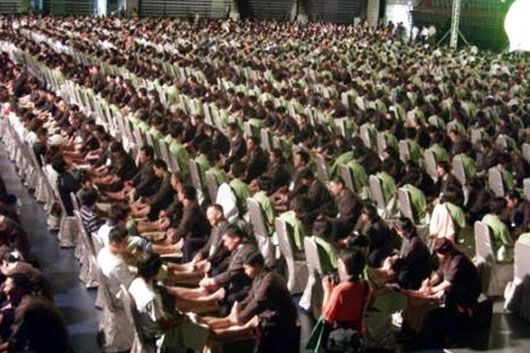Results from the 13th annual consumer survey conducted by the American Massage Therapy Association® (AMTA®) indicate that 32 percent of Americans are seeking massage for medical and health
reasons, tying relaxation and stress reduction for the first time as the top reasons people get massages.
Additionally, 25 percent of Americans ages 35-44 have talked to their doctor or healthcare provider about massage therapy this year, compared to 14 percent in 2008. Of those who discussed massage therapy with their doctors, 52 percent say their doctor strongly recommended/encouraged them to get a massage. These survey results are announced in conjunction with National Massage Therapy
Awareness Week®, October 25-31.
A vast majority of Americans, 86 percent, agree that massage can be effective in reducing pain, and 85 percent agree that massage can be beneficial for
health and wellness. “Even with the ongoing economic crisis, people are not willing to compromise their health,” says Judy Stahl, AMTA president. “It’s a clear signal of massage’s value when those making less than $35,000 a year are the second most active income bracket getting massage therapy.”
For the second year in a row, the survey results showed that massage therapy use is fairly steady, despite the lagging economy. Thirty-two percent of stressed out Americans are getting massages to relieve their stress and 57 percent of Americans say they feel more stressed this year than last year, particularly among females (61 percent) and those ages 18-24 (66 percent).
“Consumers understand that massage therapy is essential to a healthy balance between stress and relaxation,” said Stahl. “We are pleased to see that consumers are prioritizing massage to help them through these difficult times.”
Weerapong P, Hume PA, Kolt GS
Many coaches, athletes and sports medicine personnel hold the belief, based on observations and experiences, that massage can provide several benefits to the body such as increased blood flow, reduced muscle tension and neurological excitability, and an increased sense of well-being.
Massage can produce mechanical pressure, which is expected to increase muscle compliance resulting in increased range of joint motion, decreased passive stiffness and decreased active stiffness (biomechanical mechanisms). Mechanical pressure might help to increase blood flow by increasing the arteriolar pressure, as well as increasing muscle temperature from rubbing. Depending on the massage technique, mechanical pressure on the muscle is expected to increase or decrease neural excitability as measured by the Hoffman reflex (neurological mechanisms).
Changes in parasympathetic activity (as measured by heart rate, blood pressure and heart rate variability) and hormonal levels (as measured by cortisol levels) following massage result in a relaxation response (physiological mechanisms). A reduction in anxiety and an improvement in mood state also cause relaxation (psychological mechanisms) after massage.
Therefore, these benefits of massage are expected to help athletes by enhancing performance and reducing injury risk. However, limited research has investigated the effects of pre-exercise massage on performance and injury prevention. Massage between events is widely investigated because it is believed that massage might help to enhance recovery and prepare athletes for the next event. Unfortunately, very little scientific data has supported this claim. The majority of research on psychological effects of massage has concluded that massage produces positive effects on recovery (psychological mechanisms).
Post-exercise massage has been shown to reduce the severity of muscle soreness but massage has no effects on muscle functional loss. Notwithstanding the belief that massage has benefits for athletes, the effects of different types of massage (e.g. petrissage, effleurage, friction) or the appropriate timing of massage (pre-exercise vs post-exercise) on performance, recovery from injury, or as an injury prevention method are not clear.
Explanations are lacking, as the mechanisms of each massage technique have not been widely investigated. Therefore, this article discusses the possible mechanisms of massage and provides a discussion of the limited evidence of massage on performance, recovery and muscle injury prevention. The limitations of previous research are described and further research is recommended.
Sports Medicine – 2005;35(3):235-56 – abstract
 Taiwan set a World Record recently by arranging for 1008 people to have a foot massage simultaneously. The event was organized by the Taiwan tourism bureau and four Taiwan reflexology associations.
Taiwan set a World Record recently by arranging for 1008 people to have a foot massage simultaneously. The event was organized by the Taiwan tourism bureau and four Taiwan reflexology associations.
The years 2008 and 2009 had been designated as the “Tour Taiwan Years.” The Tourism Bureau has been planning a wide variety of exciting events and popular tourist attractions to draw more international visitors to Taiwan, and one of its new ideas is health care tourism.
Tourists who volunteered for the event came from various countries, including Japan, Korea, Singapore, Malaysia and Hong Kong etc. The tourists lied back on reclining chairs at the Taipei Area stadium for 40 minutes of foot massage, or reflexology treatment, given by 1,008 masseurs.
Foot massage is popular in Taiwan. In large cities in Taiwan, there are many foot massage parlours which charge 500 Taiwan dollars (15 US dollars) for 50 minutes of foot massage, which can relieve fatigue and has therapeutic effects for certain illnesses.
The previous world record stood at 200 reflexologists with the same number of tourists.
http://www.worldrecordsacademy.org/mass/most_people_having_foot_massage-world_record_set_by_Taiwan_80290.htm



